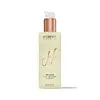What's inside
What's inside
 Key Ingredients
Key Ingredients

No key ingredients
 Benefits
Benefits

 Concerns
Concerns

 Ingredients Side-by-side
Ingredients Side-by-side

Water
Skin ConditioningSodium Cocoamphoacetate
CleansingLauryl Glucoside
CleansingGlycerin
HumectantButylene Glycol
HumectantSodium Lauroyl Sarcosinate
CleansingAcrylates/C10-30 Alkyl Acrylate Crosspolymer
Emulsion StabilisingAlthaea Officinalis Root Extract
Skin ConditioningCaprylyl Glycol
EmollientCitrus Aurantium Dulcis Peel Oil
MaskingCitrus Limon Peel Oil
MaskingCoco-Glucoside
CleansingCymbopogon Citratus Leaf/Stem Oil
MaskingDisodium EDTA
Ethylene Brassylate
MaskingEthylhexylglycerin
Skin ConditioningGlyceryl Oleate
EmollientHexylene Glycol
EmulsifyingLavandula Hybrida Oil
EmollientLinalool
PerfumingLinalyl Acetate
MaskingLitsea Cubeba Fruit Oil
MaskingMenthol
MaskingOctanal
PerfumingPhenoxyethanol
PreservativePhoenix Dactylifera Fruit Extract
EmollientSalix Alba Bark Extract
AstringentSodium Cocoyl Glutamate
CleansingSodium Hydroxide
BufferingSodium Lauryl Glucose Carboxylate
CleansingTetrasodium EDTA
Water, Sodium Cocoamphoacetate, Lauryl Glucoside, Glycerin, Butylene Glycol, Sodium Lauroyl Sarcosinate, Acrylates/C10-30 Alkyl Acrylate Crosspolymer, Althaea Officinalis Root Extract, Caprylyl Glycol, Citrus Aurantium Dulcis Peel Oil, Citrus Limon Peel Oil, Coco-Glucoside, Cymbopogon Citratus Leaf/Stem Oil, Disodium EDTA, Ethylene Brassylate, Ethylhexylglycerin, Glyceryl Oleate, Hexylene Glycol, Lavandula Hybrida Oil, Linalool, Linalyl Acetate, Litsea Cubeba Fruit Oil, Menthol, Octanal, Phenoxyethanol, Phoenix Dactylifera Fruit Extract, Salix Alba Bark Extract, Sodium Cocoyl Glutamate, Sodium Hydroxide, Sodium Lauryl Glucose Carboxylate, Tetrasodium EDTA
Water
Skin ConditioningPropanediol
SolventSodium Lauroyl Methyl Isethionate
CleansingCocamidopropyl Betaine
CleansingSodium Methyl Oleoyl Taurate
CleansingFulvic Acid
Skin ConditioningCocamidopropyl Hydroxysultaine
CleansingCoco-Glucoside
CleansingLauryl Glucoside
CleansingGlycerin
HumectantAloe Barbadensis Leaf Juice
Skin ConditioningTocopherol
AntioxidantPanthenol
Skin ConditioningSalvia Hispanica Seed Extract
EmollientHelianthus Annuus Seed Oil
EmollientAnthemis Nobilis Flower Oil
MaskingSimmondsia Chinensis Seed Oil
EmollientEthylhexylglycerin
Skin ConditioningXylitol
HumectantTetrasodium Glutamate Diacetate
Caprylyl Glycol
EmollientSodium Cocoyl Glycinate
CleansingPolysorbate 20
EmulsifyingGalactoarabinan
Trehalose
HumectantCoconut Acid
CleansingSorbitol
HumectantCitrus Paradisi Peel Oil
MaskingSodium Benzoate
MaskingSodium Chloride
MaskingSodium Phosphate
BufferingRosa Canina Seed Oil
EmollientCaprylhydroxamic Acid
Citrus Aurantium Bergamia Fruit Oil
MaskingBenzyl Alcohol
Perfuming1,2-Hexanediol
Skin ConditioningLavandula Angustifolia Oil
MaskingPrunus Amygdalus Amara Kernel Cold Pressed Oil
PerfumingCitrus Aurantifolia Oil
CleansingLitsea Cubeba Fruit Oil
MaskingLimonene
PerfumingPhenoxyethanol
PreservativeAminopropanol
Myrcene
PerfumingWater, Propanediol, Sodium Lauroyl Methyl Isethionate, Cocamidopropyl Betaine, Sodium Methyl Oleoyl Taurate, Fulvic Acid, Cocamidopropyl Hydroxysultaine, Coco-Glucoside, Lauryl Glucoside, Glycerin, Aloe Barbadensis Leaf Juice, Tocopherol, Panthenol, Salvia Hispanica Seed Extract, Helianthus Annuus Seed Oil, Anthemis Nobilis Flower Oil, Simmondsia Chinensis Seed Oil, Ethylhexylglycerin, Xylitol, Tetrasodium Glutamate Diacetate, Caprylyl Glycol, Sodium Cocoyl Glycinate, Polysorbate 20, Galactoarabinan, Trehalose, Coconut Acid, Sorbitol, Citrus Paradisi Peel Oil, Sodium Benzoate, Sodium Chloride, Sodium Phosphate, Rosa Canina Seed Oil, Caprylhydroxamic Acid, Citrus Aurantium Bergamia Fruit Oil, Benzyl Alcohol, 1,2-Hexanediol, Lavandula Angustifolia Oil, Prunus Amygdalus Amara Kernel Cold Pressed Oil, Citrus Aurantifolia Oil, Litsea Cubeba Fruit Oil, Limonene, Phenoxyethanol, Aminopropanol, Myrcene
Ingredients Explained
These ingredients are found in both products.
Ingredients higher up in an ingredient list are typically present in a larger amount.
Caprylyl Glycol is a humectant and emollient, meaning it attracts and preserves moisture.
It is a common ingredient in many products, especially those designed to hydrate skin. The primary benefits are retaining moisture, skin softening, and promoting a healthy skin barrier.
Though Caprylyl Glycol is an alcohol derived from fatty acids, it is not the kind that can dry out skin.
This ingredient is also used as a preservative to extend the life of products. It has slight antimicrobial properties.
Learn more about Caprylyl GlycolCoco-Glucoside is a surfactant, or a cleansing ingredient. It is made from glucose and coconut oil.
Surfactants help gather dirt, oil, and other pollutants from your skin to be rinsed away.
This ingredient is considered gentle and non-comedogenic. However, it may still be irritating for some.
Learn more about Coco-GlucosideEthylhexylglycerin (we can't pronounce this either) is commonly used as a preservative and skin softener. It is derived from glyceryl.
You might see Ethylhexylglycerin often paired with other preservatives such as phenoxyethanol. Ethylhexylglycerin has been found to increase the effectiveness of these other preservatives.
Glycerin is already naturally found in your skin. It helps moisturize and protect your skin.
A study from 2016 found glycerin to be more effective as a humectant than AHAs and hyaluronic acid.
As a humectant, it helps the skin stay hydrated by pulling moisture to your skin. The low molecular weight of glycerin allows it to pull moisture into the deeper layers of your skin.
Hydrated skin improves your skin barrier; Your skin barrier helps protect against irritants and bacteria.
Glycerin has also been found to have antimicrobial and antiviral properties. Due to these properties, glycerin is often used in wound and burn treatments.
In cosmetics, glycerin is usually derived from plants such as soybean or palm. However, it can also be sourced from animals, such as tallow or animal fat.
This ingredient is organic, colorless, odorless, and non-toxic.
Glycerin is the name for this ingredient in American English. British English uses Glycerol/Glycerine.
Learn more about GlycerinLauryl Glucoside sugar- and lipid-based cleansing agent. It is created from glucose and lauryl alcohol.
This ingredient is a surfactant, making it easier to rinse oil, dirt, and other pollutants away.
A British study found lauryl glucoside to cause skin sensitivity for some people. We recommend speaking with a professional if you have concerns.
Other names for this ingredient include "Lauryl Polyglucose", "Lauryl glycoside", and "D-Glucopyranoside".
Learn more about Lauryl GlucosideLitsea Cubeba Fruit Oil is a fragrance and is an oil.
Phenoxyethanol is a preservative that has germicide, antimicrobial, and aromatic properties. Studies show that phenoxyethanol can prevent microbial growth. By itself, it has a scent that is similar to that of a rose.
It's often used in formulations along with Caprylyl Glycol to preserve the shelf life of products.
Water. It's the most common cosmetic ingredient of all. You'll usually see it at the top of ingredient lists, meaning that it makes up the largest part of the product.
So why is it so popular? Water most often acts as a solvent - this means that it helps dissolve other ingredients into the formulation.
You'll also recognize water as that liquid we all need to stay alive. If you see this, drink a glass of water. Stay hydrated!
Learn more about Water